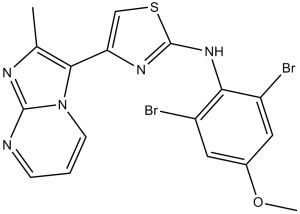PTC-209 (PTC209) is a novel, potent and selective BMI-1 inhibitor (IC50 = 0.5 μM) with potential anticancer activity. It may result in a permanent decrease in cancer-initiating cells (CICs). In human colorectal cells HCT116 and human fibrosarcoma tumor cells HT1080, PTC-209 inhibited in a dose-dependent manner both UTR-mediated reporter expression and endogenous BMI-1 expression. Furthermore, PTC-209's inhibitory action did not result from cytotoxicity. Additionally, PTC-209 specifically decreased PRC1 activity.
Physicochemical Properties
| Molecular Formula | C17H13BR2N5OS | |
| Molecular Weight | 495.19 | |
| Exact Mass | 492.92 | |
| Elemental Analysis | C, 41.23; H, 2.65; Br, 32.27; N, 14.14; O, 3.23; S, 6.48 | |
| CAS # | 315704-66-6 | |
| Related CAS # | PTC-209 hydrobromide;1217022-63-3 | |
| PubChem CID | 1117196 | |
| Appearance | Beige to grey solid powder | |
| Density | 1.9±0.1 g/cm3 | |
| Index of Refraction | 1.772 | |
| LogP | 4.13 | |
| Hydrogen Bond Donor Count | 1 | |
| Hydrogen Bond Acceptor Count | 6 | |
| Rotatable Bond Count | 4 | |
| Heavy Atom Count | 26 | |
| Complexity | 480 | |
| Defined Atom Stereocenter Count | 0 | |
| SMILES | CC1=C(C2=CSC(NC3=C(Br)C=C(OC)C=C3Br)=N2)N4C=CC=NC4=N1 |
|
| InChi Key | XVOOCQSWCCRVDY-UHFFFAOYSA-N | |
| InChi Code | InChI=1S/C17H13Br2N5OS/c1-9-15(24-5-3-4-20-16(24)21-9)13-8-26-17(22-13)23-14-11(18)6-10(25-2)7-12(14)19/h3-8H,1-2H3,(H,22,23) | |
| Chemical Name | N-(2,6-dibromo-4-methoxyphenyl)-4-(2-methylimidazo[1,2-a]pyrimidin-3-yl)-1,3-thiazol-2-amine | |
| Synonyms |
|
|
| HS Tariff Code | 2934.99.9001 | |
| Storage |
Powder-20°C 3 years 4°C 2 years In solvent -80°C 6 months -20°C 1 month |
|
| Shipping Condition | Room temperature (This product is stable at ambient temperature for a few days during ordinary shipping and time spent in Customs) |
Biological Activity
| Targets | Chk1 (IC50 = 0.3 nM); FLT3 (IC50 = 5.8 nM); PDGFR (IC50 = 606 nM); GSK-3 (IC50 = 23.3 nM) | |
| ln Vitro |
|
|
| ln Vivo |
|
|
| Enzyme Assay | The GEMS reporter vector, which is transfected into HEK293 cells, has the luciferase open-reading frame surrounded by the BMI-1 5′ and 3′ UTRs and controlled by them post-transcriptionally. Bright-Glo assays are used to measure the luciferase reporter activity after the resultant stable cells (F8) are treated with PTC-209 or vehicle control for an extended period of time. For every point, the assays are conducted three times, and the percentage of inhibition was computed in comparison to the vehicle control. | |
| Cell Assay | Cells are plated with the inhibitor for 4 days in vitro and plated in limiting doses in vitro without adding additional inhibitor to ascertain whether pretreatment with the inhibitor affects tumor cell growth. Viable cell counts are performed using trypan blue exclusion. The number of wells containing spheres is used to calculate the in vitro sphere-initiating cell frequency following inhibitor treatment. One E6 cell per well in 6-well plates was seeded and incubated overnight for the experiments where LDAs are set up after recovery of PTC-209 treated cells. After that, cells are treated in triplicate for 4 days with either PTC-209 (0.01, 0.1, 1 and 10 μM) or DMSO vehicle. After washing off the drug treatments, 4 mL of brand-new suspension medium are added to each well. Cells are trypsinized and counted at 0, 24, 72, and 120 hours after the drug is removed in order to evaluate the viability of the cells after the 4-day treatment window. By plating LDAs (50,000, 10,000, 1,000, 100, 10 and 1 cell per well) using the cells obtained 120 hours after the 4-d drug treatment, the long-lasting effects of the drug treatment on sphere-forming ability are evaluated. | |
| Animal Protocol | Formulated in 14% DMSO, 36% polyethylene glycol 400 and 50% polypropylene glycol; 60 mg/kg/day; s.c. injectionPrimary human colon cancer xenograft, human colon cancer cell lines LIM1215 and HCT116 xenografts in nude mice.Primary human colon cancer xenograft, | |
| References |
[1]. Self-renewal as a therapeutic target in human colorectal cancer. Nat Med. 2014 Jan;20(1):29-36. [2]. PTC-209 Anti-Cancer Effects Involved the Inhibition of STAT3 Phosphorylation. Front Pharmacol. 2019;10:1199. Published 2019 Oct 21. [3]. Targeting BMI1+ Cancer Stem Cells Overcomes Chemoresistance and Inhibits Metastases in Squamous Cell Carcinoma. Cell Stem Cell. 2017 May 4;20(5):621-634.e6. |
Solubility Data
| Solubility (In Vitro) |
|
|||
| Solubility (In Vivo) |
Solubility in Formulation 1: 2.5 mg/mL (5.05 mM) in 10% DMSO + 40% PEG300 + 5% Tween80 + 45% Saline (add these co-solvents sequentially from left to right, and one by one), suspension solution; with sonication. For example, if 1 mL of working solution is to be prepared, you can add 100 μL of 25.0 mg/mL clear DMSO stock solution to 400 μL PEG300 and mix evenly; then add 50 μL Tween-80 to the above solution and mix evenly; then add 450 μL normal saline to adjust the volume to 1 mL. Preparation of saline: Dissolve 0.9 g of sodium chloride in 100 mL ddH₂ O to obtain a clear solution. Solubility in Formulation 2: 1% DMSO+30% polyethylene glycol+1% Tween 80: 30 mg/mL (Please use freshly prepared in vivo formulations for optimal results.) |
| Preparing Stock Solutions | 1 mg | 5 mg | 10 mg | |
| 1 mM | 2.0194 mL | 10.0971 mL | 20.1943 mL | |
| 5 mM | 0.4039 mL | 2.0194 mL | 4.0389 mL | |
| 10 mM | 0.2019 mL | 1.0097 mL | 2.0194 mL |
